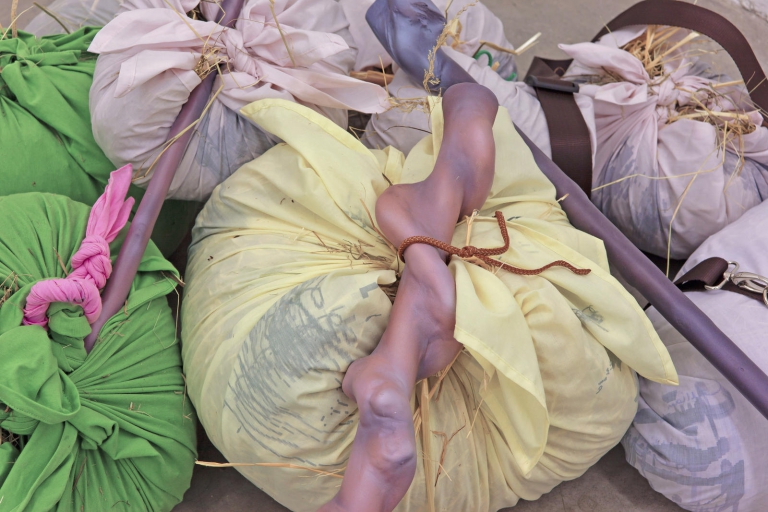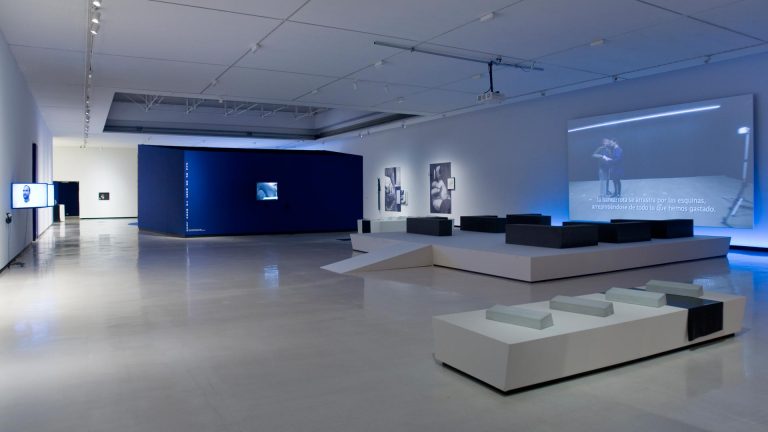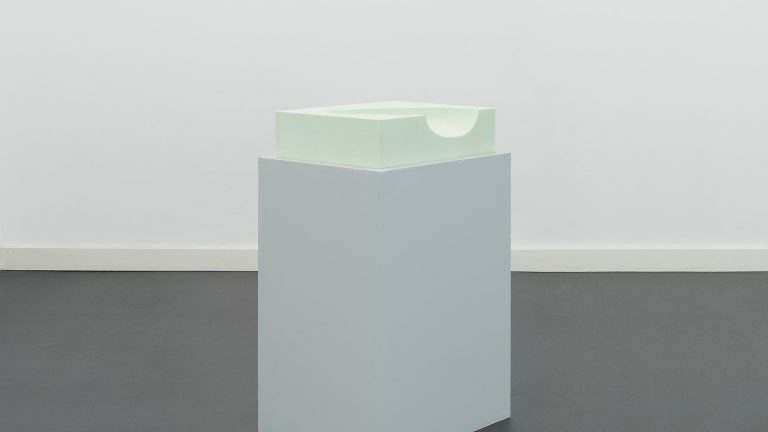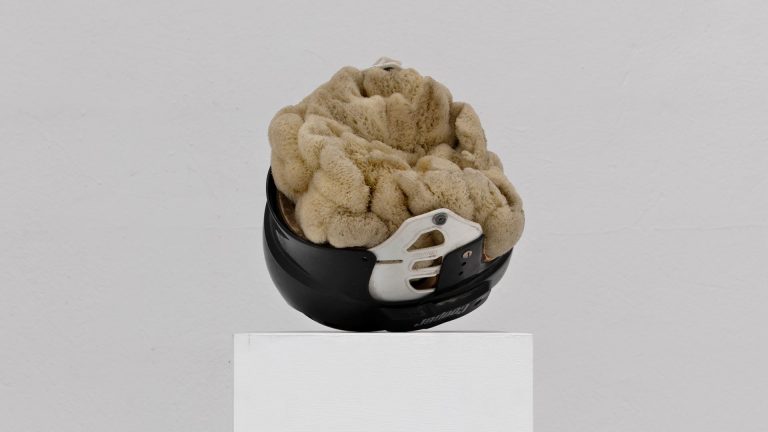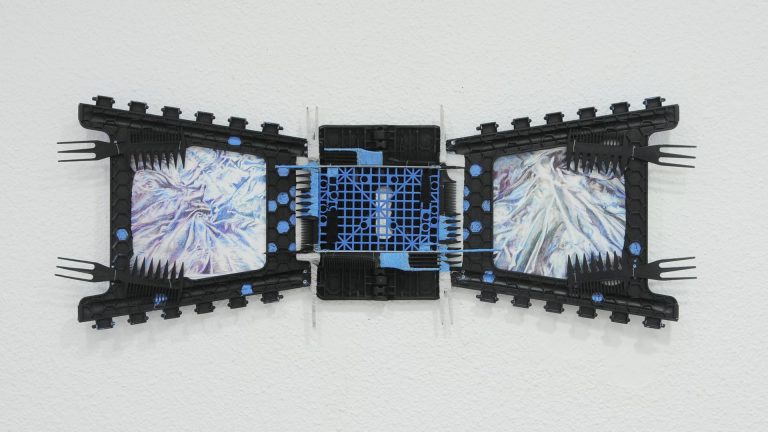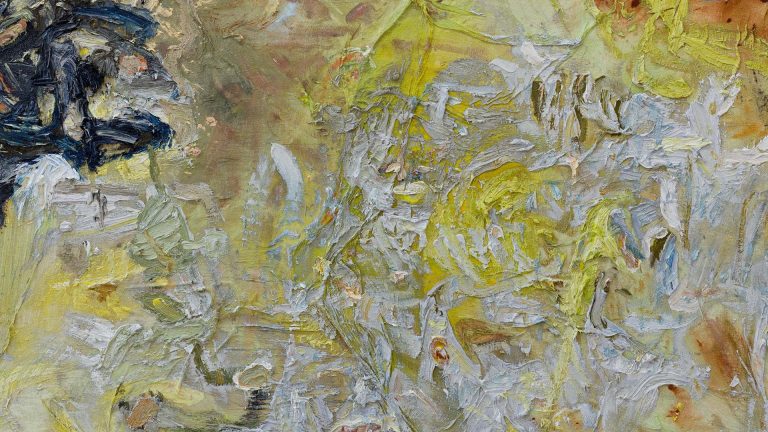Artist: Ricardo Trigo
Exhibition title: Background Immunity
Curated by: David Armengol
Venue: La Capella (BCN-Producció), Barcelona, Spain
Date: April 27 – June 12, 2016
Photography: all images copyright and courtesy of the artist
One of the central pieces of the exhibition is the video Background Immunity (2016), screened at the far end of the room. At one particular point, about halfway through, the voice of the narrator utters a message that is crucial to our reading of the work of Ricardo Trigo: “Progress is our freedom and our limitation”, a simple and contradictory phrase that accurately defines the artist’s discursive stance.
The myth of progress is in crisis and in the throes of constant technological evolution, circumstances that have had an impact on the conceptual tone of this exhibition centred on the use of particular materials in the ‘display’ in art. The artist analyses their origin and technical developments, as well as the companies and brands that invented them and sold them in the realms of industry, engineering and science. This process of research has culminated in a group of physical pieces produced using materials that convey an idea of innovation, such as synthetic resins (Plexiglas), polyester sheets (Vivak) and 3D-printed screws (ABS and copper). In this way, the display suggests another type of nexus between material and form: a tautological process in which the materiality of the pieces is not an exhibition methodology but a discursive purpose that addresses itself.
In line with this reiterative logic, the exhibition generates two independent and complementary ambits: one consisting of the two side chapels, in which a formalisation of a pictorial nature prevails; and the other, the Sala Gran itself, de ned by a video installation and a ready-made.
In the chapels, Preresolutions (2015-2016) comprises a number of pieces made using Plexiglas, a material patented in 1933 by the German scientist Otto Röhm that was employed in the cabins of Second-World-War planes and submarines. A historical detail that years later led the British ophthalmologist Harold Ridley to invent intraocular lenses after he discovered that fragments of Plexiglas did not damage the tissue in his patients’ eyes. In Trigo’s work, industrial sheets of Plexiglas are shown in a state of deterioration, with impact marks and cracks that add a new random and fortuitous formal layer.
Oriented Combustions (2015-2016) features various traces of smoke on polyester supports (Vivak) made by Bayer, the chemical and pharmaceutical company. Trigo turns his attention here to the manipulated representation of smoke in the construction of Bayer’s identity, initially championing it by means of smoking chimneys and then making it disappear due to environmental ethics. By programming a robotic arm holding a candle, the artist draws on the Vivak sheets burned forms that match the lines of smoke in various old Bayer documents.
The chapels also house Handy Rules (2016), a new series on Plexiglas and Vivak that includes graphic elements made using soap (hygiene) and aspirin (health). In both cases, Trigo opts for a gesturality that draws on technology: the tactile movement that reproduces the numerical locking code of an Android mobile.
At a second level, all the physical pieces in the exhibition contain the functional and visible presence of Performing Attachments (2014-2016), a series of 3D-printed screws made by the artist based on types of screws from different periods. In some cases, we can see that the screws have been used in a regular and orderly way; in others, we can see that they function in a more random and intuitive manner.
Lastly, we come to the exhibition’s central work in the Sala Gran, a video installation consisting of a video screened on the crates used to transport the works. Through the combination of archive images, 3D resources, the explicit manipulation of the voice and a soundtrack composed by the artist, this self- critical exercise imposes itself and questions itself as a narrative possibility. Ultimately, it is a display of the technological artice that underpins and at the same time blurs the audio-visual document.
The exhibition comes to an end with a specic intervention in the central space of La Capella: the installation of a stove that burns pellets, a renewable, environmentally-friendly fuel that reduces the CO2 emissions a lot. Inside, amid the burning pellets, we can see a number of 3D-printed screws, holding out heroically against the re in the stove. And there, in this victory, lies the libe- ration and condemnation of progress.
–David Armengol
*”Background Immunity” is part of the program BCN-Producció 2016. Aimed at the artistic community of Barcelona and its area of influence, this call encourages the execution of projects that need production resources and institutional support to develop.
Ricardo Trigo, Background Immunity, 2016
Ricardo Trigo, Background Immunity, 2016
Ricardo Trigo, Handy Rules No 1, from Aspirin to Android, 2016
Ricardo Trigo, Handy Rules No 1, from Aspirin to Android, 2016 (detail)
Ricardo Trigo, Handy Rules No 2, from Aspirin to Android, 2016
Ricardo Trigo, Handy Rules No 2, from Aspirin to Android, 2016 (detail)
Ricardo Trigo, Preresolution No 3, 2016
Ricardo Trigo, Preresolution No 3, 2016 (detail)
Ricardo Trigo, Handy Rules No 3, from Burnus to Android, 2016
Ricardo Trigo, Handy Rules No 3, from Burnus to Android, 2016 (detail)
Ricardo Trigo, Preresolution No 4, 2016
Ricardo Trigo, Handy Rules No 4, from Burnus to Android, 2016
Ricardo Trigo, Handy Rules No 4, from Burnus to Android, 2016 (detail)
Ricardo Trigo, Oriented Combustions No 4, Bayer in Leverkusen (1988) and Bayer in Elberfeld (1881), 2016
Ricardo Trigo, Oriented Combustions No 4, Bayer in Leverkusen (1988) and Bayer in Elberfeld (1881), 2016 (detail)
Ricardo Trigo, Oriented Combustions No 5, Bayer in Leverkusen (1988) and Bayer in Elberfeld (1881), 2016
Ricardo Trigo, Oriented Combustions No 5, Bayer in Leverkusen (1988) and Bayer in Elberfeld (1881), 2016 (detail)



























